Question: It is Monday, September 13, Year 10.
It is Monday, September 13, Year 10. You, CPA, work at Fife & Richardson LLP, a CPA firm. Ken Simpson, one of the partners, approaches you mid-morning regarding Brennan & Sons Limited (BSL), a private company client for which you performed the August 31, Year 9, year-end audit.
"It seems there have been substantial changes at BSL this year," Ken explains. "I'm going there tomorrow, and since you will be on the audit again this year, it would be beneficial for you to come. I took the liberty of retrieving information from last year's files so you can refresh your memory about this client" (see Exhibit I).
The next day, you and Ken meet with Jack Wright, the accounting manager at BSL. Jack gives you the internally prepared financial statements (Exhibit II). To your surprise, there are also financial statements for two new companies. Jack quickly explains that BSL incorporated two subsidiaries in January Year 10, each with the same year-end as BSL:
• Brennan Transport Ltd. (Transport)-100% owned by BSL
• Brennan Fuel Tank Installations Inc. (Tanks)--75% owned by BSL
You diligently take notes during the meeting (Exhibit Ill). Jack states that BSL will follow ASPE and will prepare consolidated financial statements to satisfy the bank's request.
Nature of the business: BSL operates as a scrap metal dealer and processor. It buys used scrap metal from individuals and businesses, then bundles the different metals and sells them in larger quantities at a higher price to bigger recycling businesses. BSL's revenue fluctuates significantly because of the volatility in the market rates for steel and non-ferrous metals. To help control costs, BSL uses its own trucks and trailers to do the pickups. BSL earns additional revenue by providing transportation services to other businesses and by renting out the trucks during slower periods.
Exhibit I:

Exhibit II:
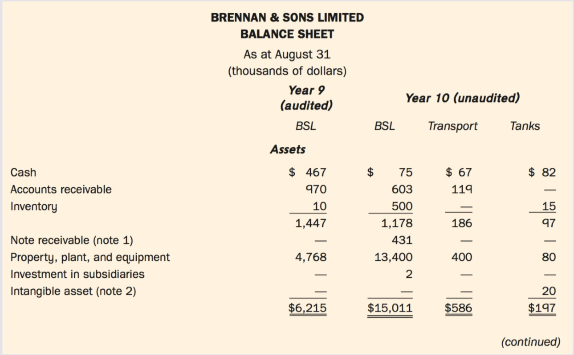
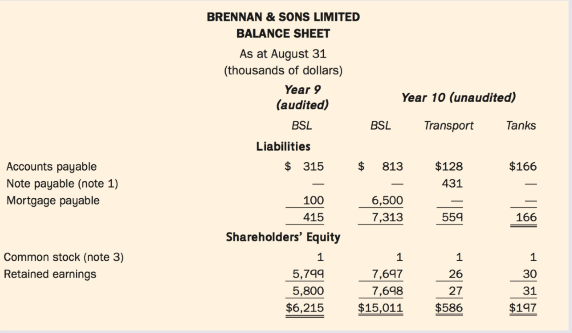
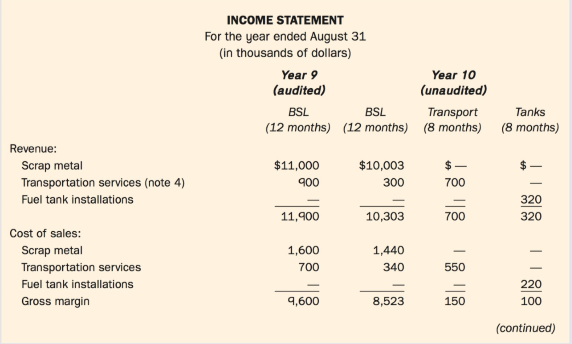
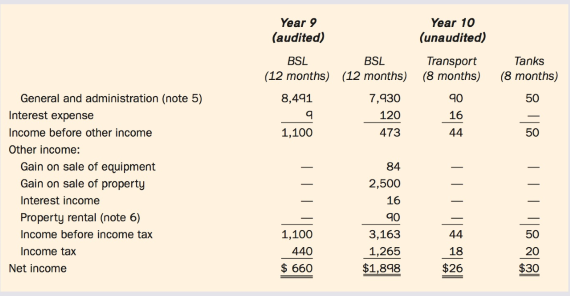
Exhibit III:

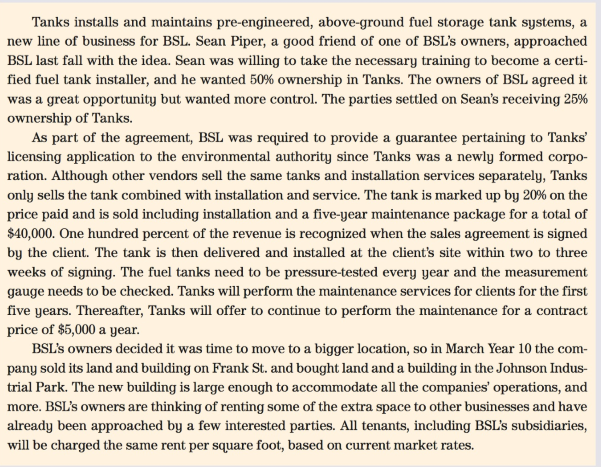
Transcribed Image Text:
Information from Last Year's Audit Files-Excerpt from Permanent File Date of incorporation: 21 years ago August 31 Year-end: Ownership: 50 common shares Harold Thomas 50 common shares Kyle Stanton BRENNAN & SONS LIMITED BALANCE SHEET As at August 31 (thousands of dollars) Year 9 Year 10 (unaudited) (audited) BSL BSL Transport Tanks Assets Cash $ 467 $ 75 $ 67 $ 82 Accounts receivable 970 603 119 Inventory 10 500 15 1,447 1,178 186 97 Note receivable (note 1) 431 - - - Property, plant, and equipment 4,768 13,400 400 80 Investment in subsidiaries Intangible Asset (note 2) 20 $6,215 $15,011 $586 $197 (continued) BRENNAN & SONS LIMITED BALANCE SHEET As at August 31 (thousands of dollars) Year 9 (audited) Year 10 (unaudited) BSL BSL Transport Tanks Liabilities Accounts payable $ 315 24 813 $128 $166 Note payable (note 1) 431 Mortgage payable 100 6,500 - - 415 7,313 559 166 Shareholders' Equity Common stock (note 3) 1. 1 Retained earnings 5,799 7,697 26 30 5,800 7,698 27 31 $6,215 $15,011 $586 $197 INCOME STATEMENT For the year ended August 31 (in thousands of dollars) Year 9 Year 10 (audited) (unaudited) BSL BSL Transport Tanks (12 months) (12 months) (8 months) (8 months) Revenue: Scrap metal $11,000 $10,003 Transportation services (note 4) 900 300 700 Fuel tank installations 320 11,900 10,303 700 320 Cost of sales: Scrap metal 1,600 1,440 Transportation services 700 340 550 Fuel tank installations 220 Gross margin 9,600 8,523 150 100 (continued) Year 9 Year 10 (audited) (unaudited) Transport (12 months) (12 months) (8 months) BSL BSL Tanks (8 months) General and administration (note 5) 8,491 7,430 90 50 Interest expense 120 16 Income before other income 1,100 473 44 50 Other income: Gain on sale of equipment 84 Gain on sale of property 2,500 Interest income 16 Property rental (note 6) 90 Income before income tax 1,100 3,163 44 50 Income tax 440 1,265 18 20 Net income $ 660 $1,898 $26 $30 BSL continues to operate the scrap metal business. BSL's management thinks the price of metal is going to go up in the near future, and has therefore started stockpiling for the first time. Unfor- tunately, BSL doesn't really have an inventory tracking system in place. If in fact it turns out stockpiling is a good way for BSL to make money, it will install a better system. The company did its best to log each of the amounts going into the stockpile as it was added, knowing that an amount for its year-end inventory balance would need to be determined. BSL also used a known engineering formula to come up with an estimate for year-end inventory and tried to measure the different piles of metal as a way of counting what was on hand at August 31, Year 10. The different methods came up with different amounts, so management went with the initial amount based on the log. Jack noted that we would have had a good laugh at the different ways they tried to measure the piles if we'd been there to see it. As soon as it was incorporated on January 1, Year 10, Transport took over BSL's transporta- tion operations. Transport provides transportation services to BSL and external customers, the same as BSL did. BSL sold the trucks to Transport in late January at fair market value; however, Transport didn't have the funds to buy the equipment, so BSL issued a note receivable at what Jack believed to be the market interest rate. (continued) Tanks installs and maintains pre-engineered, above-ground fuel storage tank systems, a new line of business for BSL. Sean Piper, a good friend of one of BSL's owners, approached BSL last fall with the idea. Sean was willing to take the necessary training to become a certi- fied fuel tank installer, and he wanted 50% ownership in Tanks. The owners of BSL agreed it was a great opportunity but wanted more control. The parties settled on Sean's receiving 25% ownership of Tanks. As part of the agreement, BSL was required to provide a guarantee pertaining to Tanks' licensing application to the environmental authority since Tanks was a newly formed corpo- ration. Although other vendors sell the same tanks and installation services separately, Tanks only sells the tank combined with installation and service. The tank is marked up by 20% on the price paid and is sold including installation and a five-year maintenance package for a total of $40,000. One hundred percent of the revenue is recognized when the sales agreement is signed by the client. The tank is then delivered and installed at the client's site within two to three weeks of signing. The fuel tanks need to be pressure-tested every year and the measurement gauge needs to be checked. Tanks will perform the maintenance services for clients for the first five years. Thereafter, Tanks will offer to continue to perform the maintenance for a contract price of $5,000 a year. BSL's owners decided it was time to move to a bigger location, so in March Year 10 the com- pany sold its land and building on Frank St. and bought land and a building in the Johnson Indus- trial Park. The new building is large enough to accommodate all the companies' operations, and more. BSL's owners are thinking of renting some of the extra space to other businesses and have already been approached by a few interested parties. All tenants, including BSL's subsidiaries, will be charged the same rent per square foot, based on current market rates.
> On January 1, Year 5, Blake Corporation purchased 25% of the outstanding common shares of Stergis Limited for $1,850,000. The following relates to Stergis since the acquisition date: Required: (a) Assume that Blake is a public company and the number of
> Baskin purchased 20,000 common shares (20%) of Robbin on January 1, Year 5, for $275,000 and classified the investment as FVTPL. Robbin reported net income of $85,000 in Year 5 and $90,000 in Year 6, and paid dividends of $40,000 in each year. Robbin's s
> Briefly describe the trend in reporting of investments in equity securities over the past 12 years.
> Harmandeep Ltd. is a private company in the pharmaceutical industry. It has been preparing its financial statements in accordance with ASPE. Since it has plans to go public in the next three to five years, it is considering changing to IFRS for the curre
> The summarized trial balances of Phase Limited and Step Limited as of December 31, Year 5, are as follows (amounts in thousands): Phase had acquired the investment in Step in three stages: The January 1, Year 2, acquisition enabled Phase to elect 3 m
> On December 31, Year 6, Ultra Software Limited purchased 70,000 common shares (70%) of a major competitor, Personal Program Corporation (PPC), at $30 per share. Several shareholders who were unwilling to sell at that time owned the remaining common share
> On January 1, Year 8, Panet Company acquired 40,000 common shares of Saffer Corporation, a public company, for $500,000. This purchase represented 8% of the outstanding shares of Saffer. It was the intention of Panet to acquire more shares in the future
> On January 1, Year 4, a Canadian firm, Canuck Enterprises Ltd., borrowed US$208,000 from a bank in Seattle, Washington. Interest of 7.5% per annum is to be paid on December 31 of each year during the four-year term of the loan. Principal is to be repaid
> The Valleytown Senior's Residential Home (Valleytown) engages in palliative care, education, and fundraising programs. The costs of each program include the costs of personnel, premises, and other expenses that are directly related to providing the progr
> The William Robertson Society is a charitable organization funded by government grants and private donations. It prepares its annual financial statements using the restricted fund method in accordance with the CPA Canada Handbook, and uses both an operat
> All facts about this NFPO are identical to those described in Problem 11, except that the deferral method of recording contributions is used for accounting and for external financial reporting. Fund accounting is not used. The Year 6 transactions are als
> The Far North Centre (the Centre) is an anti-poverty organization funded by contributions from governments and the general public. For a number of years, it has been run by a small group of permanent employees with the help of part-timers and dedicated v
> All facts about this NFPO are identical to those described in Problem 9, except that the Centre wants to use the restricted fund method of accounting for contributions. The Centre will use two separate funds--operating and capital. The capital fund will
> In Year 1, XZY Co. expensed all development costs as incurred. How would the current ratio, debt-to-equity ratio and return on equity change if XZY Co. had capitalized the development costs?
> On December 31, Year 2, PAT Inc. of Halifax acquired 90% of the voting shares of Gioco Limited of Italy, for 690,000 euros (€). On the acquisition date, the fair values equaled the carrying amounts for all of Gioco's identifiable assets
> The Ford Historical Society is an NFPO funded by government grants and private donations. It uses both an operating fund and a capital fund. The capital fund accounts for moneys received and restricted for major capital asset acquisitions. The operating
> The Brown Training Centre is a charitable organization dedicated to providing computer training to unemployed people. Individuals must apply to the center and indicate why they would like to take the three-month training session. If their application is
> All facts about this NFPO are identical to those described in Problem 5, except for the following: 1. The Society will use the restricted fund method of accounting for contributions. 2. The Society will use three separate funds for reporting purposes--
> The Fara Littlebear Society is an NFPO funded by government grants and private donations. It was established in Year 5 by the friends of Fara Littlebear to encourage and promote the work of Native Canadian artists. Fara achieved international recognition
> Protect Purple Plants (PPP) uses the deferral method of accounting for contributions and has no separate fund for restricted contributions. On January 1, Year 6, PPP received its first restricted cash contribution-$120,000 for the purchase and maintenanc
> All facts about this NFPO are identical to those described in Problem 2, except that the association wants to use the deferral method of accounting for contributions. The center will continue to use the three separate funds. Required: Prepare a stateme
> The Perch Falls Minor Hockey Association was established in Perch Falls in January Year 5. Its mandate is to promote recreational hockey in the small community of Perch Falls. With the support of the provincial government, local business people, and many
> The OPI Care Centre is an NFPO funded by government grants and private donations. It prepares its annual financial statements using the deferral method of accounting for contributions, and it uses only the operations fund to account for all activities. T
> You, CPA, are employed at Beaulieu & Beauregard, Chartered Professional Accountants. On November 20, Year 3, Dominic Jones, a partner in your firm, sends you the following email: Our firm has been reappointed auditors of Floral Impressions Ltd. (FIL)
> Identify the financial statement ratios typically used to assess profitability, liquidity and solvency, respectively.
> Foreign Infants Adoption Inc. (FIA) is a consulting company wholly owned by Roger Tremblay, a wealthy, recently retired lawyer. FIA helps Canadian families adopt infants from other countries. Typically, these infants have been abandoned or have lost thei
> Mega Communications Inc. (MCI) is a Canadian-owned public company operating throughout North America. Its core business is communications media, including newspapers, radio, television, and cable. The company's year-end is December 31. You, a CPA, have r
> RAD Communications Ltd. (RAD), a Canadian public company, recently purchased the shares of TOP Systems Inc. (TOP), a Canadian-controlled private corporation. Both companies are in the communications industry and own television, radio, and magazine and ne
> Vulcan Manufacturing Limited (VML) is a Canadian-based multinational plastics firm, with subsidiaries in several foreign countries and worldwide consolidated total assets of $500 million. VML's shares are listed on a Canadian stock exchange. VML is attra
> Long Life Enterprises was a well-€stablished Toronto-based company engaged in the importation and wholesale marketing of specialty grocery items originating in various countries of the western Pacific Rim. They had recently also entered the high-risk bus
> The Rider Corporation operates throughout Canada buying and selling widgets. In hopes of expanding into more profitable markets, the company recently decided to open a small subsidiary in California. On October 1, Year 2, Rider invested CDN$1,000,000 in
> You, CPA, have been working for Plener and Partners, Chartered Professional Accountants (P&P), a mid-size CPA firm, for three years. You have been assigned a new project for a long-term client of your firm, Oxford Developments Inc. (ODI). Information
> ZIM Inc. (ZIM) is a high-technology company that develops, designs, and manufactures telecommunications equipment. ZIM was founded in Year 5 by Dr. Alex Zimmer, the former assistant head of research and development at a major telephone company. He and th
> The United Football League (UFL), a North American professional football league, has been in work stoppage since July 1, Year 9, immediately after the six-week training camp ended. Faced with stalled negotiations, the players' union representing the leag
> Canada Cola Inc. (CCI) is a public company engaged in the manufacture and distribution of soft drinks across Canada. Its primary product is Canada Cola ("Fresh as a Canadian stream"), which is a top seller in Canada and generates large export sales. You
> For the items listed in Exhibit 1.1, for which items would the debt-to-equity ratio not change when a company switched from ASPE to IFRS? Exhibit 1.1: Accounting Item IFRS ASPE Very extensive for many items, especially financial instruments, post-e
> Interfast Corporation, a fastener manufacturer, has recently been expanding its sales through exports to foreign markets. Earlier this year, the company negotiated the sale of several thousand cases of fasteners to a wholesaler in the country of Loznia.
> Segment reporting can provide useful information for investors and competitors. Segment disclosures can result in competitive harm for the company making the disclosures. By analyzing segment information, potential competitors can identify and concentrat
> P Co. is looking for some additional financing in order to renovate one of the company's manufacturing plants. It is having difficulty getting new debt financing because its debt-to-equity ratio is higher than the 3:1limit stated in its bank covenant. It
> Mr. Landman has spent the last 10 years developing small commercial strip malls and has been very successful. He buys a residential property in a high-traffic area, rezones the property, and then sells it to a contractor who builds the plaza and sells it
> Enviro Facilities Inc. (EFl) is a large, diversified Canadian-controlled private company with several Canadian and U.S. subsidiaries, operating mainly in the waste management and disposal industry. EFl was incorporated more than 50 years ago, and has gro
> You, a CPA, have recently accepted a job at the accounting firm of Cat, Scan & Partners, as a manager, and have been assigned the audit of Vision Clothing Inc. (VCI). The partner in charge had been at VCI the previous week and had met with the contro
> Dry Quick (DQ) is a medium-sized, private manufacturing company located near Timmins, Ontario. DQ has a June 30 year-end. Your firm, Poivre & Sel (P&S), has recently been appointed as auditors for DQ. It is now August 2, Year 10. You, CPA, have b
> Traveller Bus Lines Inc. (TBL) is a wholly owned subsidiary of Canada Transport Enterprises Inc. (CTE), a publicly traded transportation and communications conglomerate. TBL is primarily in the business of operating buses over short- and long distance ro
> Identify some of the financial statement items for which ASPE is different from IFRS.
> For the past 10 years, Prince Company (Prince) has owned 75,000 or 75% of the common shares of Stiff Inc. (Stiff). Elizabeth Winer owns another 20% and the other 5% are widely held. Although Prince has the controlling interest, you would never know it du
> On December 31, Year 7, Pepper Company, a public company, agreed to a business combination with Salt Limited, an unrelated private company. Pepper issued 72 of its common shares for all (50) of the outstanding common shares of Salt 'This transaction incr
> Stephanie Baker is an audit senior with the public accounting firm of Wilson & Lang. It is February Year 9, and the audit of Canadian Development Limited (CDL) for the year ended December 31, Year 8, is proceeding. Stephanie has identified several transa
> On January 1, Year 4, Plum purchased 100% of the common shares of Slum. On December 31, Year 5, Slum purchased a machine for $168,000 from an external supplier. The machine had an estimated useful life of six years with no residual value. On December 31,
> In early September Year 1, your firm's audit client, D Ltd. (D) acquired in separate transactions an 80% interest in N Ltd. (N) and a 40% interest in K Ltd. (K). All three companies are federally incorporated Canadian companies and have August 31 year-en
> Enron Corporation's 2000 financial statements disclosed the following transaction with LIM2, a nonconsolidated special purpose entity (SPE) that was formed by Enron: In June 2000, LIM2 purchased dark fibre optic cable from Enron for a purchase price of
> Digital Future Technologies (DFT) is a public technology company. It has a September 30 year-end, and last year it adopted IFRS. Kin Lo is a partner with Hi & Lo, the accounting firm that was newly appointed as DFT's auditor in July for the year endi
> Wedding Planners Limited (WP), owned by Anne and Francois Tremblay, provides wedding planning and related services. WP owns a building (the Pavilion) that has been custom-made for hosting weddings. Usually, WP plans a wedding from start to finish and hos
> You, the CPA, an audit senior at Grey & Co., Chartered Professional Accountants, are in charge of this year's audit of Plex-Fame Corporation (PFC). PFC is a rapidly expanding, diversified, and publicly owned entertainment company with operations througho
> Briefly explain why a Canadian private company may decide to follow IFRS even though it could follow ASPE.
> Distinguish between unrestricted and restricted contributions of a charitable organization.
> Good Quality Auto Parts Limited (GQ) is a medium-sized, privately owned producer of auto parts, which are sold to car manufacturers, repair shops, and retail outlets. In March Year 10, the union negotiated a new three-year contract with the company for t
> You, the controller, recently had the following discussion with the president: President: I just don't understand why we can't recognize the revenue from the intercompany sale of inventory on the consolidated financial statements. The subsidiary company
> Gerry's Fabrics Ltd. (GFL), a private company, manufactures a variety of clothing for women and children and sells it to retailers across Canada. Until recently, the company has operated from the same plant since its incorporation under federal legislati
> Beaver Ridge Oilers' Players Association and Mr. Slim, the CEO of the Beaver Ridge Oilers Hockey Club (Club), ask for your help in resolving a salary dispute. Mr. Slim presents the following income statement to the player representatives: Mr. Slim argu
> Total Protection Limited (TPL) was incorporated on January 1, Year 1, by five homebuilders in central Canada to provide warranty protection for new-home buyers. Each shareholder owns a 20% interest in TPL. While most homebuilders provide one-year warrant
> It is now mid-September Year 3. Growth Investments Limited (GIL) has been owned by Sam and Ida Growth since its incorporation under the Canada Business Corporations Act many years ago. The owners, both 55 years of age, have decided to effect a corporate
> BIO Company is a private company. It employs 30 engineers and scientists who are involved with research and development of various biomedical devices. All of the engineers and scientists are highly regarded and highly paid in the field of biomedical rese
> It is September 15, Year 8. The partner has called you, CPA, into his office to discuss a special engagement related to a purchase agreement. John Toffler, a successful entrepreneur with several different businesses in the automotive sector, is finalizin
> Lauder Adventures Limited (LAL) was incorporated over 40 years ago as an amusement park and golf course. Over time, a nearby city has grown to the point where it borders on LAL's properties. In recent years LAL's owners, who are all members of one family
> When Valero Energy Corp. acquired Ultramar Diamond Shamrock Corp. (UDS) for US$6 billion, it created the second-largest refiner of petroleum products in North America, with over 23,000 employees in the United States and Canada, total assets of $10 billio
> Briefly explain why the Canadian AcSB decided to create a separate section of the CPA Canada Handbook for private enterprises.
> Factory Optical Distributors (FOD) is a publicly held manufacturer and distributor of high-quality eyeglass lenses located in Burnaby, British Columbia. For the past 10 years, the company has sold its lenses on a wholesale basis to optical shops across C
> On December 31, Year 7, Maple Company issued preferred shares with a fair value of $1,200,000 to acquire 24,000 (60%) of the common shares of Leafs Limited. The Leafs shares were trading in the market at around $40 per share just days prior to and just a
> Planet Publishing Limited (Planet) is a medium-sized, privately owned Canadian company that holds exclusive Canadian distribution rights for the publications of Typset Daily Corporation (TDC). Space Communications Ltd. (Space), an unrelated privately own
> How are translation exchange gains and losses reflected in financial statements if the foreign operation's functional currency is the Canadian dollar? Would the treatment be different if the foreign operation's functional currency were not the Canadian d
> What translation method should be used for a subsidiary that operates in a highly inflationary environment? Why?
> What difference does it make whether the foreign operation's functional currency is the same or different than the parent's presentation currency? What method of translation should be used for each?
> What should happen if a foreign subsidiary's financial statements have been prepared using accounting principles different from those used in Canada?
> Define a foreign operation as per IAS 21.
> How are gains and losses on financial instruments used to hedge the net investment in a foreign operation reported in the consolidated financial statements when the PCT method is used to translate the foreign operation?
> Explain how the acquisition cost is determined for a reverse takeover.
> Why might a company want to hedge its balance sheet exposure? What is the paradox associated with hedging balance sheet exposure?
> What are the three major issues related to the translation of foreign currency financial statements?
> Would hedge accounting be used in a situation in which the hedged item and the hedging instrument were both monetary items on a company's statement of financial position? Explain.
> If the sales of a foreign subsidiary all occurred on one day during the year, would the sales be translated at the average rate for the year or the rate on the date of the sales? Explain.
> When translating the financial statements of the subsidiary at the date of acquisition by the parent, the exchange rate on the date of acquisition is used to translate plant assets rather than the exchange rate on the date when the subsidiary acquired th
> Explain how the FCT method produces results that are consistent with the normal measurement and valuation of assets and liabilities for domestic transactions and operations.
> "If the translation of a foreign operation produced a gain under the FCT method, the translation of the same company could produce a loss if the operation were translated under the PCT method." Do you agree with this statement? Explain.
> The amount of the accumulated foreign exchange adjustments appearing in the translated financial statements of a subsidiary could be different from the amount appearing in the consolidated financial statements. Explain how.
> Does the FCT method use the same unit of measure as the PCT method? Explain.
> The FCT and PCT methods each produce different amounts for translation gains and losses due to the items at risk. Explain.
> When will the premium paid on a forward contract to hedge a firm commitment to purchase inventory be reported in income under a cash flow hedge? Explain.
> List some ways that a Canadian company could hedge against foreign currency exchange rate fluctuations.
> Differentiate between the accounting for a fair value hedge and a cash flow hedge.
> Differentiate between a spot rate and a closing rate.
> Describe when to use the closing rate and when to use the historical rate when translating assets and liabilities denominated in a foreign currency. Explain whether this practice is consistent with the way we normally measure assets and liabilities.
> How are foreign-currency-denominated assets and liabilities measured on the transaction date? How are they measured on a subsequent balance sheet date?
> Differentiate between a spot rate and a forward rate.
> You read in the newspaper, "One U.S. dollar can be exchanged for 1.15 Canadian dollars." Is this a direct or an indirect quotation? If your answer is indirect, what is the direct quotation? If your answer is direct, what is the indirect quotation?
> What is the difference between pegged and floating exchange rates?
> What is meant by hedge accounting?
> What is the suggested financial statement presentation of hedge accounts recorded under the gross method? Why?
> When long-term debt hedges a revenue stream, a portion of the long-term debt becomes exposed to the risk of changes in exchange rates. Why is this?
> How does the accounting for a fair value hedge differ from the accounting for a cash flow hedge of an unrecognized firm commitment?

